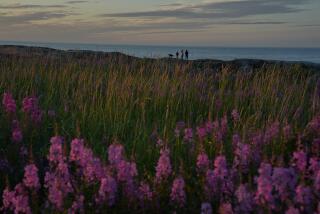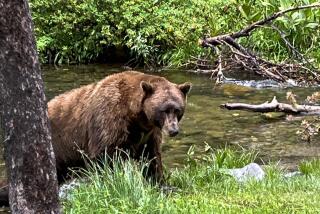Alaska Villagers Keep Alert as More Polar Bears Prowl : Wildlife: Conversation centers on avoiding attacks by the largest land predator. You can’t run or always hide.
BARROW, Alaska — Tires squeak over dry snow as Morgan Soloman stops his pickup and gazes across the raggedly beautiful ice beyond. At the moment, he is as far north as anyone can go in the United States, armed, ready and relaxed, pulling the day shift of the North Slope Borough’s Polar Bear Patrol.
From out on the bluish fluorescence of the Arctic Ocean ice pack, no wandering predatory eyes return his stare, this time.
So Soloman resumes his rounds--a Far North twist on the neighborhood watch program, to lighten the foreboding of the 3,800 villagers of Barrow who find themselves living shoulder-to-shoulder these days with the greatest predator now walking the Earth.
“It got a little out of hand here. Polar bears got to like they wanted to take over,” Soloman says. “Our job is to make sure that people understand what they’re up against. Once a polar bear is hungry, he knows no law.”
These days, when humans move about in the darkness and twilight of winter America’s northernmost outpost, they watch over their shoulders. The banging of a shutter in the wind is enough to stop hearts for a beat. When it comes to polar bears, you cannot possibly run, and, as one unfortunate man discovered when a bear came crashing through a window, you cannot always hide.
So 24 hours a day, seven days a week since October, the Inupiat Eskimo villagers of Barrow and Kaktovik send patrols through town to scare off bears or, if that fails, to meet them with a 12-gauge slug.
Elsewhere on the Arctic North Slope, at the military’s Distant Early Warning radar stations and at the Prudhoe Bay oil fields, anxiety runs high and the talk of the dinner table is how to survive this ghostly environment amid these largest of land predators.
The good news is that polar bears are enlarging their numbers about 2% a year, thanks to conservation efforts in the five high-latitude countries that ring the North Pole. The not-so-good news is that hungry young bears in this expanding population are being driven outward into new ranges, where they increasingly encounter those nervous and dangerous counter-predators, us.
In the last few years, the growing bear population and quirky ice conditions combined to bring more polar bears than ever in memory into areas settled by humans.
“Some people are downright scared,” says Steven C. Amstrup, polar bear project leader with the National Biological Survey.
“Bears are required by their evolutionary history to investigate everything in their environment. If they don’t, they are not going to survive. So we can count on bears encountering humans in the future.”
The Arctic winter darkness, with temperatures of 30-below in steady winds of 20 to 30 knots, is a dramatic scene for these meetings. But only a rare few end up bloody, thanks to the reverence and mystique and fear of the ice bears, which the Inupiat call nanuq .
In recent weeks, scientists have counted 40 to 50 polar bears feeding on a whale carcass just south of Barrow. Another group is known to hang out at the end of the road to the north, including a sow who has made her den here. Some villagers say they see three or four bears a day, others say they hardly see any--and are thankful for it.
But virtually everyone comes across bear prints. And since the wind smooths the snow like so much sand, there is no such thing as an old track.
In Kaktovik to the east, bears are suspected of vandalism at the tundra landing strip. All over the oil fields, the lights of industry illuminate the roamings of these sleek, long-necked carnivores with their black eyes and black noses and a hunger that drives them to cover 100,000 square miles in a year.
Most upsetting to the few thousand men and women who live their winters in the Arctic was the Dec. 1 attack at a military radar station at Oliktok Point, between Barrow and Prudhoe Bay. Two men saw a bear peering into their window. One man swatted the glass with a magazine. Rather than being shooed off, the bear lunged through the glass, just as it might leap through a hole in the ice to grab a seal.
Inside, a 55-year-old mechanic was bitten and clawed. The man ended up in serious condition in a hospital. Another worker shot the bear with a 12-gauge. It was a young male with an empty belly and no reserves of body fat.
This was the first recorded attack of a polar bear into a human shelter in the United States. Three years earlier, a polar bear attacked and ate a man in the coastal village of Point Lay, the only fatal encounter in 70 years of native memory.
These are not the kind of statistics to bring out the National Guard. But many here are spooked nonetheless. The North Slope Regional Corp., the Inupiat governing body, enlisted extra security for Halloween trick-or-treaters. School bus stops are regularly patrolled. Twelve-gauge shotguns are as common in cars, homes and offices as umbrellas are in Seattle. And everybody, no matter how the frozen wind stings their face, keeps their head up and their eyes wide open when walking the streets.
Marie Adams, an Inupiaq born and raised in Barrow, works in an office at the edge of town only a few feet from the jumbled ice blocks and pressure ridges of the frozen ocean. Adams’ husband is well known in town for the time he clubbed a charging bear and stunned it long enough for someone to shoot it. She is answering questions about life among the carnivores.
“I don’t let it limit what I do. But you have to be a little more careful.”
The sound of an approaching helicopter interrupts. She pauses to listen. “Hope they haven’t found a bear,” she says in a worried voice.
Now, where was she? Oh yes, she laughs, compared to Los Angeles, she would “definitely feel safer here with the bears and other animals.”
Contrary to the myths of the Arctic, this is not a land of 24 hours of darkness. Although the sun never rises, it comes close enough to the horizon to lighten the sky for several hours each midday, illuminating the landscape in vivid blue-white.
Morgon Solomon’s day shift takes him from the road north at Point Barrow back to town--a road, which if extended 3,500 miles, as he likes to imagine, would connect him to U.S. 101 and the beachfront of Santa Monica. He passes a house decorated with bright holiday lights. Strung up alongside is a seven-foot polar bear skin. The woman inside shot the bear outside her office.
At another house, two fresh skins are spread on the ice. The meat has been distributed to the senior citizens center. Just yesterday a seal hunter was surprised at close range by the approaching animals.
Under U.S. law, polar bears are protected, although not endangered. Hunting by non-natives was outlawed in 1972, by which time virtually all of the old and large bears of the region had been killed. However, the Inupiat and Yupik native people of the north and west coasts of Alaska, those commonly called Eskimos, continue to be unrestricted in how many bears they may take for food and traditional crafts.
“Do we respect polar bears? Yes. We respect them up in this part of the country. They’ve been with us all along. Back in the old days, the ocean would sometimes be closed (with ice) and we would need them for food. That’s how much we respect them.,” says Soloman, a graying grandfather who speaks with near poetic love for the cycles of native life, even in this age of big oil, big money, jet planes and electric-heated homes.
As he expresses it, animals are not killed by natives. They are caught. And the seasons of the year are charted not by the extremes of weather but by the parade of creatures that are caught for food--first the bowhead whales in spring, then the geese, then the salmon and char and grayling, then the walrus and seals, followed by the caribou and then sometimes, in winter, the polar bear.
Native leaders have imposed their own conservation standards for bears, and government scientists say the Inupiat and Yupik harvest has remained steady at about 120 to 125 polar bears per year, even as the overall population of bears that pass through Alaska has increased to something between 5,000 and 7,000. Today, bears of all sizes, up to 1,700 pounds, and all ages, up to 30 years old, are known to range in Alaska.
Some natives are quietly working to change the law and permit them to guide non-native trophy hunts for polar bears as a way to bring income into villages. State and federal authorities in Alaska have indicated support for this idea as a way to gain overall management control of polar bears. Other natives, however, vigorously oppose the idea. They fear such a move ultimately could compromise public support for native subsistence hunting, fishing and whaling rights.
Of more immediate concern to the future of the bear are the policies of Russia. In the 1950s, the Soviet Union pioneered protection for polar bears, allowing no hunting at all. An estimated 60% of the bears that range into Alaska also wander across Russia, and U.S. officials say they have been notified that the Russians intend to resume trophy hunting of bears to bring in tourist dollars.
Here in Barrow, darkness has fallen. Benny Akootchook assumes the night shift of the Wildlife Department’s polar bear patrol.
His is the Arctic of the storybooks--an electric green aurora of Northern Lights flares horizon-to-horizon across sky shot with stars, and the strange luminescence flickers off the ice and snow.
South of town, on the edge of the Arctic Ocean, where fantastic blocks of ice could easily hide a bear, or a hundred bears, Akootchook stops the pickup and steps out.
Akootchook unexpectedly whoops and whistles. This is not official polar bear patrol policy, but a burst of felicity from a man expressing innocent fondness for his distant place in the world. “Ha Ha. No polar bears. When I am out, the polar bears go away. I cause them no problems, they give me a break. Ha ha. Too bad there are no trees here, eh?, to make some scenery for us. . . . Let’s go. We’ll keep those polar bears away.”
More to Read
Sign up for Essential California
The most important California stories and recommendations in your inbox every morning.
You may occasionally receive promotional content from the Los Angeles Times.










